麦田怪圈中英文共28页
- 格式:ppt
- 大小:4.64 MB
- 文档页数:28
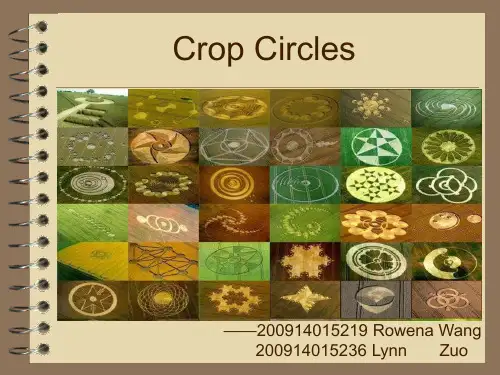
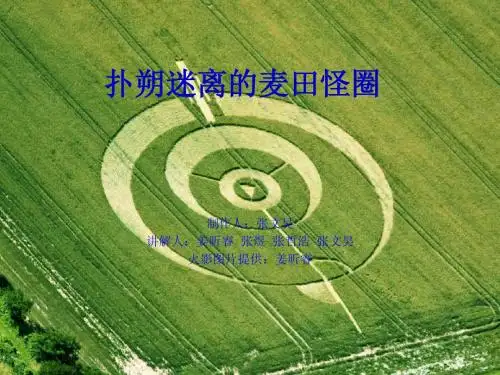
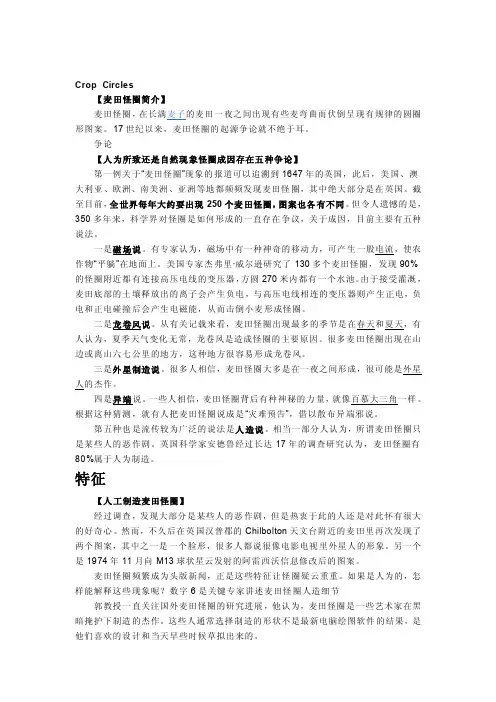
Crop Circles【麦田怪圈简介】麦田怪圈,在长满麦子的麦田一夜之间出现有些麦弯曲而伏倒呈现有规律的圆圈形图案。
17世纪以来,麦田怪圈的起源争论就不绝于耳。
争论【人为所致还是自然现象怪圈成因存在五种争论】第一例关于“麦田怪圈”现象的报道可以追溯到1647年的英国,此后,美国、澳大利亚、欧洲、南美洲、亚洲等地都频频发现麦田怪圈,其中绝大部分是在英国。
截至目前,全世界每年大约要出现250个麦田怪圈,图案也各有不同。
但令人遗憾的是,350多年来,科学界对怪圈是如何形成的一直存在争议,关于成因,目前主要有五种说法。
一是磁场说。
有专家认为,磁场中有一种神奇的移动力,可产生一股电流,使农作物“平躺”在地面上。
美国专家杰弗里·威尔逊研究了130多个麦田怪圈,发现90%的怪圈附近都有连接高压电线的变压器,方圆270米内都有一个水池。
由于接受灌溉,麦田底部的土壤释放出的离子会产生负电,与高压电线相连的变压器则产生正电,负电和正电碰撞后会产生电磁能,从而击倒小麦形成怪圈。
二是龙卷风说。
从有关记载来看,麦田怪圈出现最多的季节是在春天和夏天,有人认为,夏季天气变化无常,龙卷风是造成怪圈的主要原因。
很多麦田怪圈出现在山边或离山六七公里的地方,这种地方很容易形成龙卷风。
三是外星制造说。
很多人相信,麦田怪圈大多是在一夜之间形成,很可能是外星人的杰作。
四是异端说。
一些人相信,麦田怪圈背后有种神秘的力量,就像百慕大三角一样。
根据这种猜测,就有人把麦田怪圈说成是“灾难预告”,借以散布异端邪说。
第五种也是流传较为广泛的说法是人造说。
相当一部分人认为,所谓麦田怪圈只是某些人的恶作剧。
英国科学家安德鲁经过长达17年的调查研究认为,麦田怪圈有80%属于人为制造。
特征【人工制造麦田怪圈】经过调查,发现大部分是某些人的恶作剧,但是热衷于此的人还是对此怀有很大的好奇心。
然而,不久后在英国汉普郡的Chilbolton天文台附近的麦田里再次发现了两个图案,其中之一是一个脸形,很多人都说很像电影电视里外星人的形象。
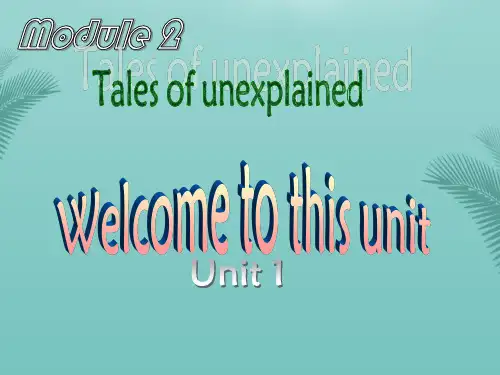
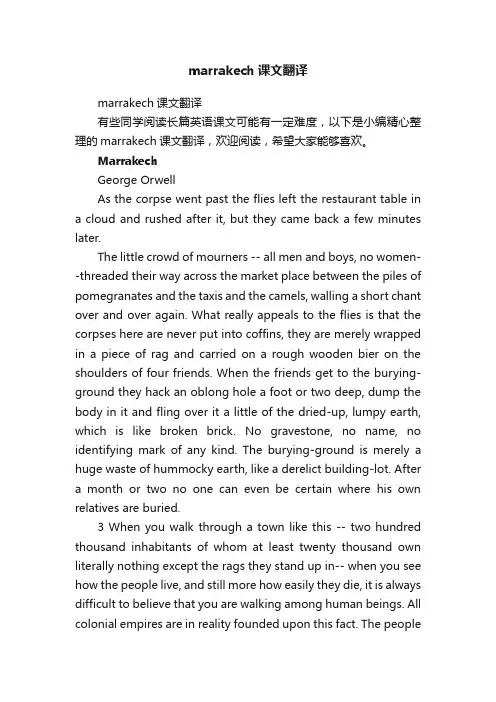
marrakech课文翻译marrakech课文翻译有些同学阅读长篇英语课文可能有一定难度,以下是小编精心整理的marrakech课文翻译,欢迎阅读,希望大家能够喜欢。
MarrakechGeorge OrwellAs the corpse went past the flies left the restaurant table in a cloud and rushed after it, but they came back a few minutes later.The little crowd of mourners -- all men and boys, no women--threaded their way across the market place between the piles of pomegranates and the taxis and the camels, walling a short chant over and over again. What really appeals to the flies is that the corpses here are never put into coffins, they are merely wrapped in a piece of rag and carried on a rough wooden bier on the shoulders of four friends. When the friends get to the burying-ground they hack an oblong hole a foot or two deep, dump the body in it and fling over it a little of the dried-up, lumpy earth, which is like broken brick. No gravestone, no name, no identifying mark of any kind. The burying-ground is merely a huge waste of hummocky earth, like a derelict building-lot. After a month or two no one can even be certain where his own relatives are buried.3 When you walk through a town like this -- two hundred thousand inhabitants of whom at least twenty thousand own literally nothing except the rags they stand up in-- when you see how the people live, and still more how easily they die, it is always difficult to believe that you are walking among human beings. All colonial empires are in reality founded upon this fact. The peoplehave brown faces--besides, there are so many of them! Are they really the same flesh as your self? Do they even have names? Or are they merely a kind of undifferentiated brown stuff, about as individual as bees or coral insects? They rise out of the earth,they sweat and starve for a few years, and then they sink back into the nameless mounds of the graveyard and nobody notices that they are gone. And even the graves themselves soon fade back into the soil. Sometimes, out for a walk as you break your way through the prickly pear, you notice that it is rather bumpy underfoot, and only a certain regularity in the bumps tells you that you are walking over skeletons.I was feeding one of the gazelles in the public gardens.Gazelles are almost the only animals that look good to eat when they are still alive, in fact, one can hardly look at their hindquarters without thinking of a mint sauce. The gazelle I was feeding seemed to know that this thought was in my mind, for though it took the piece of bread I was holding out it obviously did not like me. It nibbled nibbled rapidly at the bread, then lowered its head and tried to butt me, then took another nibble and then butted again. Probably its idea was that if it could drive me away the bread would somehow remain hanging in mid-air.An Arab navvy working on the path nearby lowered his heavy hoe and sidled slowly towards us. He looked from the gazelle to the bread and from the bread to the gazelle, with a sort of quiet amazement, as though he had never seen anything quite like this before. Finally he said shyly in French: "I could eat some of that bread."I tore off a piece and he stowed it gratefully in some secret place under his rags. This man is an employee of the municipality.When you go through the Jewish Quarters you gather someidea of what the medieval ghettoes were probably like. Under their Moorish rulers the Jews were only allowed to own land in certain restricted areas, and after centuries of this kind of treatment they have ceased to bother about overcrowding. Many of the streets are a good deal less than six feet wide, the houses are completely windowless, and sore-eyed children cluster everywhere in unbelievable numbers, like clouds of flies. Down the centre of the street there is generally running a little river of urine.In the bazaar huge families of Jews, all dressed in the long black robe and little black skull-cap, are working in dark fly-infested booths that look like caves. A carpenter sits crosslegged at a prehistoric lathe, turning chairlegs at lightning speed. He works the lathe with a bow in his right hand and guides the chisel with his left foot, and thanks to a lifetime of sitting in this position his left leg is warped out of shape. At his side his grandson, aged six, is already starting on the simpler parts of the job.I was just passing the coppersmiths booths when somebody noticed that I was lighting a cigarette. Instantly, from the dark holes all round, there was a frenzied rush of Jews, many of them old grandfathers with flowing grey beards, all clamouring for a cigarette. Even a blind man somewhere at the back of one of the booths heard a rumour of cigarettes and came crawling out, groping in the air with his hand. In about a minute I had used up the whole packet. None of these people, I suppose, works less than twelve hours a day, and every one of them looks on a cigarette as a more or less impossible luxury.As the Jews live in self-contained communities they follow the same trades as the Arabs, except for agriculture. Fruitsellers, potters, silversmiths, blacksmiths, butchers, leather-workers,tailors, water-carriers, beggars, porters -- whichever way you look you see nothing but Jews. As a matter of fact there are thirteen thousand of them, all living in the space of a few acres. A good job Hitlet wasnt here. Perhaps he was on his way, however. You hear the usual dark rumours about Jews, not only from the Arabs but from the poorer Europeans."Yes mon vieux, they took my job away from me and gave it to a Jew. The Jews! They re the real rulers of this country, you know. They’ve got all the money. They control the banks, finance -- everything.""But", I said, "isnt it a fact that the average Jew is a labourer working for about a penny an hour?""Ah, thats only for show! They re all money lenders really. They re cunning, the Jews."In just the same way, a couple of hundred years ago, poor old women used to be burned for witchcraft when they could not even work enough magic to get themselves a square meal. square mealAll people who work with their hands are partly invisible, and the more important the work they do, the less visible they are. Still, a white skin is always fairly conspicuous. In northern Europe, when you see a labourer ploughing a field, you probably give him a second glance. In a hot country, anywhere south of Gibraltar or east of Suez, the chances are that you dont even see him. I have noticed this again and again. In a tropical landscape ones eye takes in everything except the human beings. It takes in the dried-up soil, the prickly pear, the palm tree and the distant mountain, but it always misses the peasant hoeing at his patch. He is the same colour as the earth, and a great deal less interesting to look at.It is only because of this that the starved countries of Asia and Africa are accepted as tourist resorts. No one would think of running cheap trips to the Distressed Areas. But where the human beings have brown skins their poverty is simply not noticed. What does Morocco mean to a Frenchman? An orange grove or a job in Government service. Or to an Englishman? Camels, castles, palm trees, Foreign Legionnaires, brass trays, and bandits. One could probably live there for years without noticing that for nine-tenths of the people the reality of life is an endless back-breaking struggle to wring a little food out of an eroded soil.Most of Morocco is so desolate that no wild animal bigger than a hare can live on it. Huge areas which were once covered with forest have turned into a treeless waste where the soil is exactly like broken-up brick. Nevertheless a good deal of it is cultivated, with frightful labour. Everything is done by hand. Long lines of women, bent double like inverted capital Ls, work their way slowly across the fields, tearing up the prickly weeds with their hands, and the peasant gathering lucerne for fodder pulls it up stalk by stalk instead of reaping it, thus saving an inch or two on each stalk. The plough is a wretched wooden thing, so frail that one can easily carry it on ones shoulder, and fitted underneath with a rough iron spike which stirs the soil to a depth of about four inches. This is as much as the strength of the animals is equal to. It is usual to plough with a cow and a donkey yoked together. Two donkeys would not be quite strong enough, but on the other hand two cows would cost a little more to feed. The peasants possess no harrows, they merely plough the soil several times over in different directions, finally leaving it in rough furrows, after which the whole field has to be shaped with hoes into small oblong patches to conserve water. Except for aday or two after the rare rainstorms there is never enough water.A long the edges of the fields channels are hacked out to a depth of thirty or forty feet to get at the tiny trickles which run through the subsoil.Every afternoon a file of very old women passes down the road outside my house, each carrying a load of firewood. All of them are mummified with age and the sun, and all of them are tiny. It seems to be generally the case in primitive communities that the women, when they get beyond a certain age, shrink to the size of children. One day poor creature who could not have been more than four feet tall crept past me under a vast load of wood. I stopped her and put a five-sou piece ( a little more than a farthing ) into her hand. She answered with a shrill wail, almost a scream, which was partly gratitude but mainly surprise. I suppose that from her point of view, by taking any notice of her, I seemed almost to be violating a law of nature. She accepted her status as an old woman, that is to say as a beast of burden. When a family is travelling it is quite usual to see a father and a grown-up son riding ahead on donkeys, and an old woman following on foot, carrying the baggage.But what is strange about these people is their invisibility. For several weeks, always at about the same time of day, the file of old women had hobbled past the house with their firewood, and though they had registered themselves on my eyeballs I cannot truly say that I had seen them. Firewood was passing -- that was how I saw it. It was only that one day I happened to be walking behind them, and the curious up-and-down motion of a load of wood drew my attention to the human being beneath it. Then for the first time I noticed the poor old earth-coloured bodies, bodies reduced to bones and leathery skin, bent double underthe crushing weight. Yet I suppose I had not been five minutes on Moroccan soil before I noticed the overloading of the donkeys and was infuriated by it. There is no question that the donkeys are damnably treated. The Moroccan donkey is hardly bigger than a St. Bernard dog, it carries a load which in the British Army would be considered too much for a fifteen-hands mule, and very often its packsaddle is not taken off its back for weeks together. But what is peculiarly pitiful is that it is the most willing creature on earth, it follows its master like a dog and does not need either bridle or halter . After a dozen years of devoted work it suddenly drops dead, whereupon its master tips it into the ditch and the village dogs have torn its guts out before it is cold.This kind of thing makes ones blood boil, whereas-- on the whole -- the plight of the human beings does not. I am not commenting, merely pointing to a fact. People with brown skins are next door to invisible. Anyone can be sorry for the donkey with its galled back, but it is generally owing to some kind of accident if one even notices the old woman under her load of sticks.As the storks flew northward the Negroes were marching southward -- a long, dusty column, infantry , screw-gun batteries, and then more infantry, four or five thousand men in all, winding up the road with a clumping of boots and a clatter of iron wheels.They were Senegalese, the blackest Negroes in Africa, so black that sometimes it is difficult to see whereabouts on their necks the hair begins. Their splendid bodies were hidden in reach-me-down khaki uniforms, their feet squashed into boots that looked like blocks of wood, and every tin hat seemed to be a couple of sizes too small. It was very hot and the men had marched a long way. They slumped under the weight of theirpacks and the curiously sensitive black faces were glistening with sweat.As they went past, a tall, very young Negro turned and caught my eye. But the look he gave me was not in the least the kind of look you might expect. Not hostile, not contemptuous, not sullen, not even inquisitive. It was the shy, wide-eyed Negro look, which actually is a look of profound respect. I saw how it was. This wretched boy, who is a French citizen and has therefore been dragged from the forest to scrub floors and catch syphilis in garrison towns, actually has feelings of reverence before a white skin. He has been taught that the white race are his masters, and he still believes it.But there is one thought which every white man (and in this connection it doesnt matter twopence if he calls himself a socialist) thinks when he sees a black army marching past. "How much longer can we go on kidding these people? How long before they turn their guns in the other direction?"It was curious really. Every white man there had this thought stowed somewhere or other in his mind. I had it, so had the other onlookers, so had the officers on their sweating chargers and the white N. C. Os marching in the ranks. It was a kind of secret which we all knew and were too clever to tell; only the Negroes didnt know it. And really it was like watching a flock of cattle to see the long column, a mile or two miles of armed men, flowing peacefully up the road, while the great white birds drifted over them in the opposite direction, glittering like scraps of Paper.(from Reading for Rhetoric, by Caroline Shrodes,Clifford A. Josephson, and James R. Wilson)马拉喀什见闻乔治·奥威尔一具尸体抬过,成群的苍蝇从饭馆的餐桌上瓮嗡嗡而起追逐过去,但几分钟过后又非了回来。


a r X i v :a s t r o -p h /9910278v 2 14 O c t 1999ωCentauri:Nucleus of a Milky Way Dwarf Spheroidal?S.R.Majewski 1∗,R.J.Patterson 1,D.I.Dinescu 1,W.Y.Johnson 1,J.C.Ostheimer 1,W.E.Kunkel 2and C.Palma 11University of Virginia,Charlottesville,Virginia,USA 2Las Campanas Observatory,Carnegie Institution of Washington,La Serena,Chile Abstract:We derive the metallicity distribution for the globular cluster ωCentauri,and combine this with both a new determination of its orbit as well as its other unique properties to argue that ωCen may be the remains of a formerly larger dwarf galaxy that has undergone substantial tidal stripping.1Introduction We focus on two aspects of ωCen that are rather uncharacteristic of globular clusters:its metallicity distribution and its orbit.Of course,ωCen has other properties,such as mass and shape,that lend support to the idea that it is a “transitional”object with properties between those of dwarf galaxies and globular clusters.A dependence of kinematics on metallicity (Norris et al.1997,“NFMS”)and an apparent dependence of spatial distribution on metallicity within the cluster (Jurcsik 1998),bring even more complexity to the question of ωCen’s origin.Given the spread in our metallicity distribution function (MDF),as derived from Washington +DDO photometry,as well as the orbital parameters of ωCen and the other unusual aspects named above,we propose that this object is the remains (nucleus)of a once larger satellite dwarf galaxy that has been substantially reduced by tidal stripping.2Photometric CatalogueOur color magnitude diagram (CMD;Fig.1),containing over 130,000stars,was constructed from CCD images taken on UT March 15-17,1997with the Swope 1-m at Las Campanas Observatory through the Washington M and T 2filters and covering ∼1deg 2around ωCen.We also have images in the gravity-sensitive,intermediate-band DDO 51filter,which allows us to discriminate foreground field dwarfs from giants (Majewski et al.1999,“MOKP”).We proceed by limiting our analysis to all stars with magnitude errors <0.05mag.Next,by using the (M −DDO 51)o color,which is sensitive to the Mg features around 5150˚A ,we weed out dwarfs from giants (MOKP;Fig.2);this exercise is particularly helpful for finding stray,metal-rich ωCen giants among Galactic foreground stars,and allows us to explore the cluster to low densities without fear of Galactic dwarf contamination.Metallicities are obtained from the secondary dependence of the DDO 51filter on metallicity,andFigure1:ωCen color-magnitude(left)and Hess diagrams(right)of the giant branch region. the metallicity scale is obtained(Fig.2;see MOKP)by adjusting the Paltoglou&Bell(1994)synthetic photometry to stars observed spectroscopically by Suntzeff&Kraft(1996,“SK”).The“raw”MDF is shown in Fig.3(dashed+solid lines).As a check on the possibility offield giant contamination in our sample,we obtained radial velocities from Du Pont2.5-m spectra for all of the giant stars with1.35<(M−T2)o<1.40.The velocities of this sample show a rather sharp division in that all but one of31giant stars with photometric[Fe/H]>−1.19are not members of ωCen(and the one member in this interval has a photometric[Fe/H]=−1.14),while all32giants with lower photometric[Fe/H]areωCen members.Presumably the non-member giants are from the field disk population.We have applied this near-step-function membership probability distribution to correct the MDF,as shown in Fig.3(solid lines).Our technique becomes insensitive outside of −2.23<[Fe/H]<−0.47,and we show outliers at the edge of our MDF.3DiscussionWe discuss several particularly germane features ofωCen:MASS and SHAPEThe chemical composition ofωCen has long been recognized as atypical for glob-ulars.A number of papers have analyzed the MDF,and agree that it is at least very wide,with a tail towards high[Fe/H](Norris at al.1996,SK).Our results affirm the significant spread,with a well populated MDF at all[Fe/H]where our technique is sensitive,but with few stars having[Fe/H]∼>−1.2. The spread points to a complex formation process,and one that may have left a curiously inhomoge-neous spatial and kinematical distribution of stars with different[Fe/H](Jurcsik1998,NFMS).AGEThe orbit ofωCen is also rather unusual in that it is relatively strongly retrograde,but ofFigure2:Color-color diagram for separating giants and dwarfs.All stars from Fig.1with magnitude errors less than0.05mag are included.Lines of various[Fe/H]for giants are shown.Figure3:Raw(dashed+solid lines) and corrected(solid line)MDF forωCen giants from Fig.2with(M−T2)o≥1.3.Stars with[Fe/H]≤−2.23 ([Fe/H]≥−0.47)are put into edge bins.a small size,and relatively confined to the Galactic plane.A comparison to other clusters is made in Fig.4,which shows orbital inclination to the Galactic plane,Ψ,versus the normalized orbital angular momentum,L z/L z,max(where L z is the actual angular momentum,and L z,max the orbital angular momentum of a circular orbit of the same total energy).The upper-left panel of Fig.4shows all clusters with orbital data(38clusters),withωCen labeled.The other panels show different groups of clusters defined by their horizontal branch(HB)morphology and metallicity(Zinn1996):BHB –blue HB clusters for their metallicity(typicalfirst-parameter clusters),MP–metal poor clusters ([Fe/H]<−1.8),and RHB–red HB clusters for their metallicity(second-parameter clusters).Two metal-rich disk clusters are also labeled in the BHB sample.From the standpoint of the orbital trends in Fig.4alone,ωCen shows the worstfit with the very cluster group to which it normally would be assigned,i.e.,the BHB group.A better orbital match is had with the RHB group,however,the size(and therefore total energy)ofωCen’s orbit is much smaller than that of the RHB clusters(the smallest apocentric radius in the RHB group is∼11kpc, compared to6.4kpc forωCen,Dinescu et al.1999),and,in any case,ωCen has an unambiguous, very blue HB.The mean[Fe/H]ofωCen is only slightly higher than the upper limit for the MP group,which also might be taken to show a better match toωCen’s orbital properties;however,the one cluster(NGC6779)in the MP group with an orbit almost as extreme asωCen is actually about0.3dex more metal poor(at[Fe/H]=−1.94).A possible scenario producing a strongly retrograde orbit with small apocentric radius and closely confined to the Galactic plane is thatωCen originated in,or as,a massive satellite(that happened to have an originally retrograde orbit)that experienced significant dynamical friction from the dark halo,and subsequently also from the disk,before it underwent significant disruption.The present mass ofωCen is unlikely to have generated strong enough dynamical friction to modify its orbit to its presently small apocentric radius.This proposed scenario resembles the N-body models of Walker et al.(1996,“WMH”),which show that inclined orbits of satellitesfirst sink towards the Galactic plane before substantial radial decay of the orbit,and significant disruption,ensue.In their models, retrograde satellites face considerable shredding as they pass through the disk.In light of the characteristics that makeωCen unique among Galactic globular clusters,we suggest thatωCen may be the surviving nucleus of a dwarf spheroidal that has been accreted by the Galaxy. The abundance,age and orbital parameters ofωCen are consistent with such an origin,and a present-day counterpart of this process can be seen in the Sagittarius dSph system,for which the globular cluster M54,which has a mass similar toωCen,has been purported to be the nucleus(e.g.,Bassino& Muzzio1995).The idea that some globular clusters may be the remains of dwarf nucleated ellipticalsFigure4:Orbital parameters for classes of globular clusters.(Zinnecker et al.1988,Freeman1993)mayfind representatives in M54andωCen.Moreover,the WMH models predict that the surviving remnants of merging satellites form compact,globular cluster-like bodies as they burrow through the disk.Under this scenario,the more diffuse outer envelope of proto-ωCen would have been accreted by the Milky Way and contributed to thefield halo and thick disk populations.In addition,a disintegrating proto-ωCen plowing through the disk backwards may have contributed substantial disk heating,perhaps aiding thick disk formation(see WMH). AcknowledgementsThis research was supported in part by an NSF CAREER Award,a David and Lucile Packard Foun-dation Fellowship,and a Cottrell Scholar Award from the Research Corporation to SRM. ReferencesBassino,L.P.&Muzzio,J.C.1995,Observatory,115,256Dinescu D.I.,Girard T.M.&van Altena W.F.,1999,AJ117,1792Freeman K.C.,1993,ASP Conf.Series,Vol.48,608Geyer E.H.,Nelles,B.&Hopp U.,1983,A&A125,359Jurcsik J.,1998,ApJ506,L113Majewski S.R.,Ostheimer J.C.,Kunkel W.E.,Patterson,R.J.,1999,AJ,submitted(MOKP) Merritt D.,Meylan G.&Mayor M.,1997,AJ114,1074Norris J.E.,Freeman K.C.,Mayor M.&Seitzer P.,1997,ApJ,487,L187(NFMS)Norris J.E.,Freeman K.C.&Mighell K.J.,1996,ApJ462,241Paltoglou G.&Bell R.A.,1994,MNRAS268,793SuntzeffN.B.&Kraft R.P.,1996,AJ111,1993(SK)Walker,I.R.,Mihos,J.C.&Hernquist,L.1996,ApJ,460,121(WMH)White R.E.&Shawl S.J.,1987,ApJ317,246Zinnecker,H.,Keable,C.J.,Dunlop,J.S.,Cannon,R.D.&Griffiths,W.K.1988,in IAU Symposium126,ed.J.E.Grindlay&A.G.Davis Philip(Dordrecht:Kluwer),p.603.Zinn R.1996,in The Galactic Halo...Inside and Out,ASP Conf.Ser.Vol.92,eds.H.Morrison,A.Sarajedini,(San Francisco:ASP)p.211。
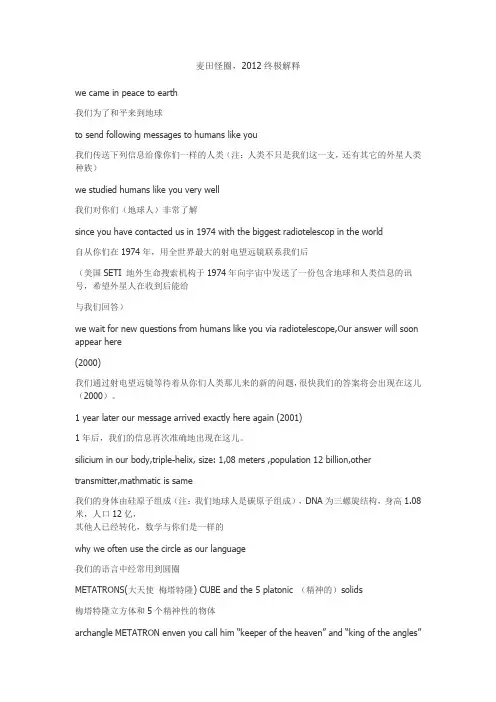
麦田怪圈,2012终极解释we came in peace to earth我们为了和平来到地球to send following messages to humans like you我们传送下列信息给像你们一样的人类(注:人类不只是我们这一支,还有其它的外星人类种族)we studied humans like you very well我们对你们(地球人)非常了解since you have contacted us in 1974 with the biggest radiotelescop in the world自从你们在1974年,用全世界最大的射电望远镜联系我们后(美国SETI 地外生命搜索机构于1974年向宇宙中发送了一份包含地球和人类信息的讯号,希望外星人在收到后能给与我们回答)we wait for new questions from humans like you via radiotelescope,Our answer will soon appear here(2000)我们通过射电望远镜等待着从你们人类那儿来的新的问题,很快我们的答案将会出现在这儿(2000)。
1 year later our message arrived exactly here again (2001)1年后,我们的信息再次准确地出现在这儿。
silicium in our body,triple-helix, size: 1,08 meters ,population 12 billion,other transmitter,mathmatic is same我们的身体由硅原子组成(注:我们地球人是碳原子组成),DNA为三螺旋结构,身高1.08米,人口12亿,其他人已经转化,数学与你们是一样的why we often use the circle as our language我们的语言中经常用到圆圈METATRONS(大天使梅塔特隆) CUBE and the 5 platonic (精神的)solids梅塔特隆立方体和5个精神性的物体archangle METATRON enven you call him “keeper of the heaven” and “king of the angles”大天使梅塔特隆你们称呼他“天堂的守护者”和“天使之王”metatrons(梅塔特隆) cube describes our universe in micro-and macro cosmos 梅塔特隆立方体从微观和宏观上描述了我们的宇宙nature is always following this principle大自然总是遵循这个法则4 elements: fire,earth,air,water + universe (ether)4 种元素:火,土,气,水+ 宇宙(以太)the highest law in nature自然界中最高的准则all compared in the “SACRED STAR TETRAHEDRON”(神圣之星四面体)所有的(元素)都以神圣之星四面体为参照Tetrahetron(四面体): 4 squares(正方形)= FIRE 火四面体:4 个正方体= 火tetrahedron was our first complex message to you in 1991四面体是我们在1991年传递给你们的第一个复杂的信息hexahedron(六面体): 6 squares = EARTH六面体:6 个正方体= 土we displayed often the hexahedron (cube) to you我们经常展示给你们看的是六面体octahedron(八面体): 8 squares = AIR八面体:8 个正方体= 气can you see the octahedron你们能看得到八面体吗?dodecahedron(十二面体): 12 squares = WATER十二面体:12 个正方体= 水we often showed you examples for this (12 squares)我们经常展示就象这样的12面体的图案icosahedron(二十面体): 20 squares = UNIVERSE二十面体:20 个正方体= 宇宙circle with 20 parts,insides 2 times(倍)20 rays(射线)… harmony(和谐)of the universe由20个部分组成的圆环,其中包含2倍20条射线,构成了和谐的宇宙star tetrahedron(星辰四面体): 6 two dimensional ends(二维结束)= KEY OF LIFE星辰四面体:6 个二维的结束= 生命的钥匙can human understand us now… or do you need more examples人类现在能理解我们了吗,还是需要更多的例子metatrons(梅塔特隆) cube with star tetrahedron inside梅塔特隆立方体,其中包含着星辰四面体metatrons cube + star tetrahedron different pictures possible like the evolution in nature梅塔特隆立方体+ 星辰四面体不同的图案组合可能就象自然界的进化过程mathmatics is the key to all: constant(常数)number of nature PI = 3,141592654…数学是揭开所有事物之谜的线索:自然界的常数PI(圆周率)= 3,141592654…all is infinety(无穷), no beginning and no ending…所有的都是无穷无尽的,没有起点也没有终点even the golden ratio(黄金比例)describles(描述)life就象描述生命的黄金比例也是如此golden ratio: constant number in nature黄金比例:自然界的常数we know human DNA structure from 1974 SETI and have this message for you我们从1974年SETI发给我们的信号中了解了人类的DNA,现在我们有条信息要传递给你们prepare for a new step in evolution是你们准备好适应一个新的进化阶段even the Mayas told you… 21.12.2012 (winter solstice)(冬至)就象玛雅人告诉你们的。

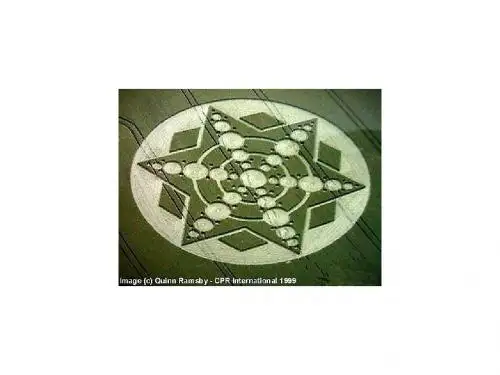
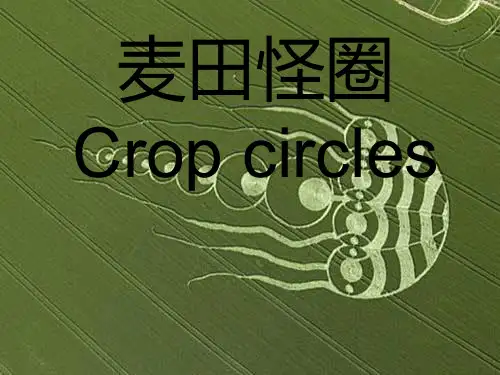
麦田怪圈In the UK farmers recall simple circles appearing on their land for generations. The British media first reported on the circles in the early 1980s. By 1990 crop circles had exploded into the public mind as the new phenomenon changed from simple circular patterns into huge and complex, geometric formations. The crop circles are a world-wide phenomenon and each year new reports come from an ever increasing number of countries. However, the main concentration of events are to be found in Southern England, many around ancient sites such as Stonehenge, Avebury and Silbury Hill (the largest manmade mound in Europe).在英国,农夫们可以追述到数代人以前,简单的圆圈图案已经出现在麦田内。
英国媒体在八十年代初期,首次报导这些麦田神秘圆圈图案。
到了九十年代麦田圈震憾世界各地人士,因为这些神秘的圆圈图案由简单的图形变成面积巨大、充满高深的几何学又复杂的美丽图案!麦田圈是全球出现的现象,每年新的图案在各地以令人难以置信的数目冒出。
终的来说全球的注意力都集中在英国南部,这里出现的数量最多而且也出现在靠近上古文明遗迹如:史前巨石阵、埃夫伯里(英国威尔特郡一村庄,附近有球形白垩石砌坑壁等新石器时代遗迹)和Silbury 山(欧洲最大的史前人造山)。
1983年,科林·艾爵斯(ColinAndrews)成立“国际圆圈现象研究中心”(CPRI),该中心出现,在麦田里出现的怪圈正在以一个圈慢慢进化成两个或者三个相对称的图形,到1994年,甚至还出现了蝎子、蜜蜂、花等动物图形。
2001年8月出现在白马山附近的一个巨大麦田圈却让很多人不得不相信,它绝不是人造的。
这个麦田怪圈范围很广,走到中间要30分钟,一共由409个圆组成。
而最近,在俄罗斯,一向惊现于农作物里的怪圈,这一次却呈现在克拉斯诺达尔边疆的向日葵地里,而且向日葵倒伏成的圆形图案精美至极,令人叹为观止。
紧接着,俄罗斯人在陶里亚蒂的荞麦地发现的神秘怪圈,竟然就在居民楼的附近。
英国人在1983年起发现麦田圈,在麦田圈的麦田周围没有任何足迹,圈内麦秆因弯曲而倒下,并未折断,可以断定不是用脚压出的。
麦田圈内的辐射量较大,其麦子的收获量不但不减少,反而生产量提高----圈内麦子多产40%、土壤有微量幅射、且常与UFO出没有关,有人亲眼看到一个美丽的麦田圈三秒钟内就在面前形成,并未看到任何物体在附近出现。
更有人拍下麦田圈瞬间成形途中,上空的确有一群UFO飞来飞去十数秒的片段。
此外,奇怪的是麦田圈上的植物没有折断的痕迹,只是植物的生长方向有不寻常变化。
根据麦田圈的形状发展历史,由小型进步为大型;由简单线条进展为复杂曲线图案,包括几何图形、动物形貌、计算机图画、文字等等。
如此而来,各种关于“麦田圈”如何形成的揣测应运而生,虽然无论是“人为恶作剧”、“外星人飞碟降临”还是“闪电激流导致”,到现在定论都还一时无法获得。
不过,专门针对“麦田圈”而开发的旅游项目却已经层出不穷,因为有谁不想亲身去触摸神秘地带的腹部呢?过去有古宅游、庄园游,无一不打着玄秘旗臶,游客兴奋地怀揣着关于“闹鬼”、“幽灵”、“宝藏”好奇心,入住美国南卡罗莱纳农场庄园,下榻新奥尔良法国区的千年古宅……如今,在英国威斯特郡也因为最早留下图片记载“麦田圈”而成为旅游胜地,一度盛况空前。
2021麦田怪圈2001年6月25日国英uftonwrwacishkrei介:质小麦介:01年6月2日英国5威尔特郡hiwteleetsillh,rneme介r:质麦小介质:0102年6月2英日威尔国特郡iddlnitognacsle介质t大麦:介质:2100年5月9日英国尔威特郡stonheneg质:介菜油质介:10年5月1日6英国威尔特郡yrnaubyrasclet质:油介菜介质:2100年5月31日国威尔特英郡silubrhilly介质:大介麦质:021年5022日英国月威特郡wil尔ot(wnnimdlli介质:油菜)介质:中心向从外看,可观看以它显示了到拉欧定,理从心中外观向,可以看看到显示它了欧定理,拉^e(i)pi1+0=,个这被称最美丽为的数,定学的公式理。
学定的公式。
理月616日国威尔特英郡hirconbotttmo质:大麦介介:质神麦田秘圈怪的性共鬼多圈构成数于晚,上常就是通子夜凌至四时晨,构成度速不可思议麦。
田附于打听不将近出任至何、动人或机物械领的之下痕迹没有人,亲眼睹目圆圈图至的案生产程过。
动物靠近现场,田圈出麦现前握失止。
常.在2麦田附近纸壳常木患明照亮或异声常。
作响3全然没有.存有糟溃痕迹,非并残害或Sommi机压而弱,成穗麦甩被下而变方向改为,榖子丝却桑利县毫。
.4麦秆漩窝状的以模式下,弯倒位曲的炭分置子构受电磁场影结而响晶结茎,曲但并弯没外力有扭结或断折的痕,迹仍且在长成。
5麦田.内的幅射圈量附与近常正的麦田比相显明较大,其麦的子获收不但量减不反而增,加,甚至多产04%名的麦著田圈母6之.形以绝图对准确一千的绘算,常画用套复极的杂何几形,或图入黄金隔开。
最小跨度的行田圈达18麦0多米,足球比还大场最。
卤的为丛藓科扭口藓麦田圈共圆存有040多圆,个被为“表示麦圈田母之麦田”圈之。
母7农.作物一定依方女性主义好像,成规状的则旋或直线状螺,时分层存有编织最多,超过五可以,层每但颗作仍像是物精巧排安般秩一井然。